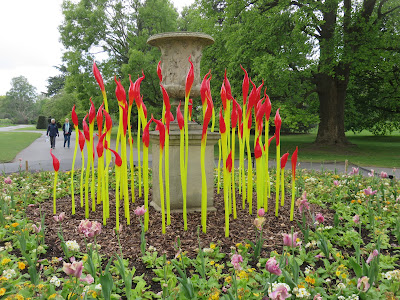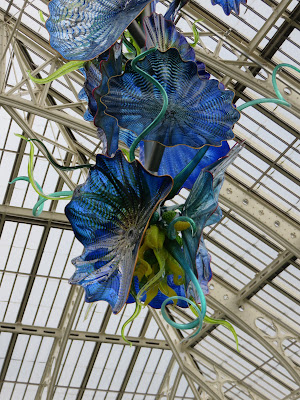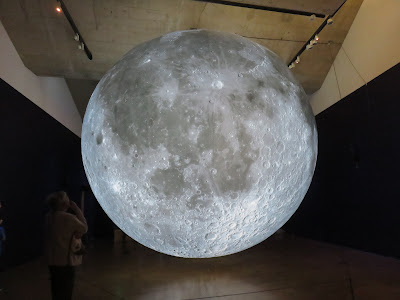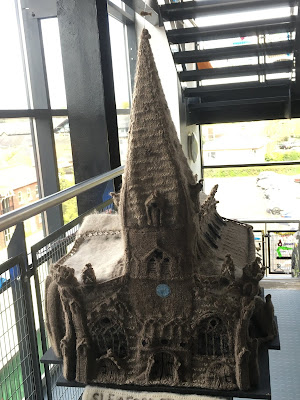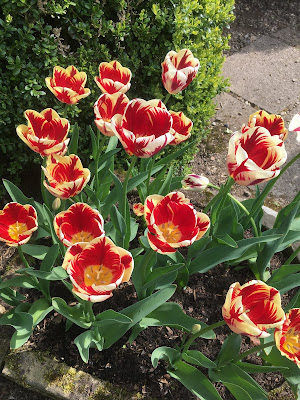Not all the family was able to stay beyond Easter Weekend, so we were a smaller party by Tuesday
We started with a visit to the International Bomber Command Memorial, which is just outside Lincoln.
During WW2, Lincolnshire was the home of most of the air force's bombers, including 617 Squadron (The Dambusters), and the Bomber Command Centre, where the memorial stands, includes a small museum and details of all of the airfields.
The memorial itself references the planes which flew then - it's height is 102', which is the wingspan of a Lancaster .
Surrounding it are walls of remembrance, recording the names of all of the airmen and ground and support staff staff who were killed during the war - almost 58,000 of them.
It's austerely beautiful, and very moving.
From the site, there are excellent views over Lincoln, including the cathedral, and we also got to see the Red Arrows in the distance over the city.
After visiting the memorial, we visited Tattersall Castle which is owned by the National Trust, having been acquired by Lord Curzon in 1910, to prevent it being torn down and sold to America, and passed on by him to the Trust on his death. (There was not a great amount left, much of the castle was destroyed in the Civil War, so all that is left is the main tower and the gate house)
The Castle dates back to 1231, the current one was built in around 1440. It is unusual in being built of brick rather than stone.
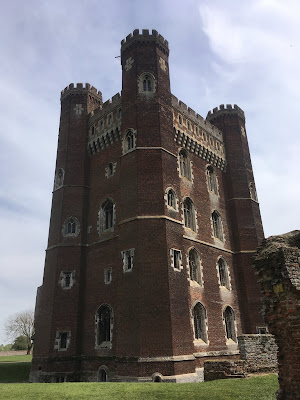 |
| Tattersall Castle |
It was a ruin when Lord Curzon bought it, and he arranged for renovations and installed a lot of stained glass, showing the coats of arms of various families associated with the castle.
It has a good deal of graffiti, showing that people have been writing their names on walls for hundreds of years!
As well as the castle, Tattersall has a set of Bedeshouses (Almshouses,connected to a church, whose inhabitants would be expected to pray for the souls of the benefactor) the original almshouses were built in the 15th Century by Lord Cromwell, who also built the Castle.(According to the information boards, he decided to erect them in thankfulness for having returned safely from Agincourt)
There is also a rather beautiful church, which was built between 1465 and 1485, and which is tall and light and airy. (apparently it is an excellent example of Perpendicular Gothic architecture, for those who are into such things)
Most of the windows are now plain glass (which enhances the lightness of the church) but there is some medieval glass in the chancel, although it isn't in its original configuration.
 |
| Tattersall Church - Stained Glass |
The church also features the grave of Tom Thumb, who was a resident of the town and died in 1620 at the age of 101.
Having watched a number of Typhoon planes flying upside down, and flying loops and things, we then went to the viewing area of RAF Conigsby and watched them taking off for a little while, then went off to Old Bolingbroke Castle, which is a proper ruin!
As the name suggests, it was owned by John f Gaunt and was the birthplace of Henry Bolingbroke, later King Henry IV - it then fell into disrepair, was re-fortified during the Civil War, as a Royalist Stronghold, and was destroyed during a siege and never repaired.
Now, it's a peaceful site, with bits of the moat remaining, full of rushes and (currently) ducklings!

